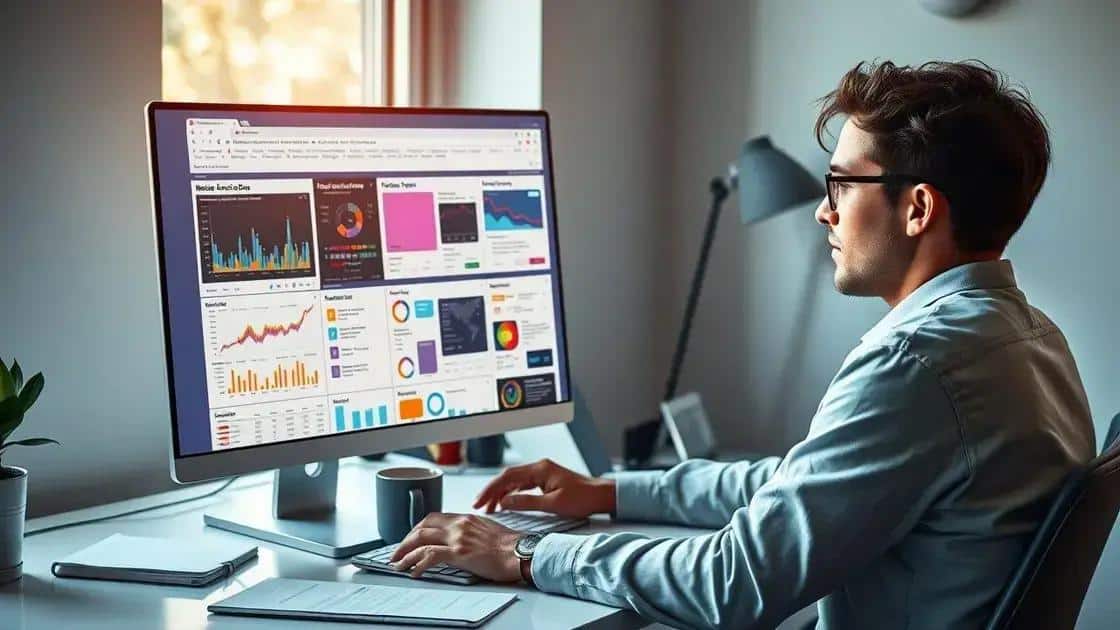Media bias tracking tools and reports: uncover the truth

Media bias tracking tools help consumers identify and analyze the political leanings and reliability of news sources, enhancing critical engagement with media and fostering informed decision-making.
Media bias tracking tools and reports are essential for anyone keen on unearthing the truth behind the news. Have you ever wondered how some stories tend to lean one way or another? This article will guide you through the best tools available to help you navigate media representation.
Understanding media bias and its impact
Understanding media bias is crucial for consuming news effectively. Media bias refers to the perceived or actual bias of journalists and news producers within the mass media. It influences the way stories are presented, shaping public perception.
This impacts how we view the world. Each piece of news can be colored by the choices made in reporting. For instance, two different news outlets might report on the same event but highlight distinct aspects, leading to different interpretations.
Types of Media Bias
There are several types of media bias that you should be aware of:
- Bias by omission: Leaving out important facts can skew a story.
- Bias by selection: Choosing which stories to cover affects public perception.
- Bias by placement: The location of stories can change their importance.
- Bias by labeling: Describing individuals or groups in a specific way can create a bias.
Recognizing these biases helps in critical thinking as we consume news. Understanding that not all messages are constructed equally opens doors to deeper analysis.
Why it Matters
The effects of media bias extend beyond individual news stories. They can shape societal norms and political agendas. When we become aware of these biases, we can discern which reports might be misleading and pursue a more rounded understanding of events.
Additionally, biased reporting can lead to polarization. When audiences only hear desired narratives, it can create an echo chamber, where opposing views are dismissed. This environment hinders constructive dialogue and fuels conflict.
In summary, recognizing media bias and understanding its impacts equips us to navigate the complex landscape of information. Being informed helps us respond to news with a critical eye, fostering a more informed society.
Top media bias tracking tools to consider

When it comes to identifying media bias, utilizing the right tools can make all the difference. Several effective tracking tools can provide insights into how news is reported. Understanding these tools will help you analyze media messages better.
Among the most popular options are:
1. Media Bias Fact Check
This website offers a comprehensive database of news sources, indicating their editorial bias. It categorizes news outlets based on their political leanings and reliability. Users can search for any outlet to determine its bias quickly.
2. AllSides
AllSides presents news stories from multiple perspectives. It allows readers to see how the same event is covered by diverse news outlets, helping to reveal potential bias. Users can filter news by various categories, making it easier to understand different viewpoints.
3. Ad Fontes Media
This tool rates news sources on a bias scale and media reliability. It provides a visual representation called the Media Bias Chart, showing where different outlets fall on the political spectrum. This visual aid helps in recognizing bias at a glance.
Using tools like these can empower you to consume news more critically. They encourage you to question the source and the story presented. A key aspect of understanding media bias is recognizing that reporting is often not neutral.
In addition, integrating these tools into your news consumption habits helps cultivate a well-rounded perspective. When you consider various biases, you form a clearer picture of events happening in the world around you. Investing time in these tools equips you with the necessary skills to navigate today’s complex media landscape.
How to interpret media bias reports
Interpreting media bias reports requires a critical eye and some understanding of how news is constructed. These reports give you insights into the leanings of various news sources, and knowing how to read them can enhance your media literacy significantly.
To interpret these reports effectively, consider the following:
Understand the Bias Ratings
Most media bias reports categorize sources based on their political leanings. Familiarize yourself with the meaning of terms like “left-leaning,” “right-leaning,” or “center.” Recognizing these classifications helps you understand a source’s perspective.
Look for Source Reliability
Alongside bias, reliability is another key factor. Reliable sources will typically fact-check their information and provide evidence to back their claims. When interpreting reports, check if the outlet has a history of misreporting or sensationalism.
Consider Contextualization
Often, reports will place bias in context. This means analyzing how a story is presented and what information it includes or omits. Understanding the context helps in assessing whether a report is designed to sway opinions or inform the public.
After understanding these factors, you can apply critical thinking. Consider the content of the news article, its language and the images used. These elements can reflect bias even outside what Bias Reports indicate.
Engaging with media bias reports not only improves your ability to discern bias, but also encourages a habit of questioning the news you consume. You learn to seek out diverse perspectives and place them in a broader context. This habit is essential in mitigating the effects of misinformation and polarization.
Practical tips for using bias tracking tools

Using bias tracking tools effectively can enhance your ability to consume news critically. Here are some practical tips that can help you get the most out of these resources.
1. Familiarize Yourself with Different Tools
Before diving into analysis, take some time to explore various bias tracking tools available online. Each tool has unique features and insights, which can offer a richer understanding of media bias. Spend a few minutes checking out websites like AllSides, Media Bias Fact Check, and Ad Fontes Media.
2. Cross-Reference Information
Don’t rely on a single source for assessing bias. Use multiple tools to cross-reference information. For example, if one tool rates a news outlet as left-leaning, check other tools to see if they have similar ratings. This validation can provide more confidence in your assessment.
3. Analyze the Reports Thoroughly
When you receive a report from a bias tracking tool, read through it carefully. Pay attention to specific criteria the tool uses for bias detection, such as language choice, story selection, and source reliability.
- Look for definitions of bias provided by the tool.
- Understand their rating system and what it signifies.
- Identify any patterns in the news outlet’s reporting style over time.
This detailed analysis will deepen your understanding of how bias can affect news stories.
4. Stay Updated
Bias tracking tools often update their assessments based on new data and events. Check back regularly to see how outlets may have changed. Staying informed on these updates ensures you have the latest understanding of media bias.
Equipping yourself with these practical tips can greatly enhance your media literacy and improve your ability to navigate the complex world of news.
FAQ – Frequently Asked Questions about Media Bias Tracking Tools
What are media bias tracking tools?
Media bias tracking tools analyze news sources to determine their political leanings and reliability, helping users identify biased reporting.
How can I benefit from using these tools?
By using bias tracking tools, you can make informed decisions about which news sources to trust and be more critically engaged with the media.
Are there specific tools I should start with?
Yes, some popular tools include AllSides, Media Bias Fact Check, and Ad Fontes Media, which offer various insights into media bias.
How often should I check for updates on media bias?
It’s a good idea to regularly check updates, as media outlets can change their reporting styles and biases based on new information and events.






